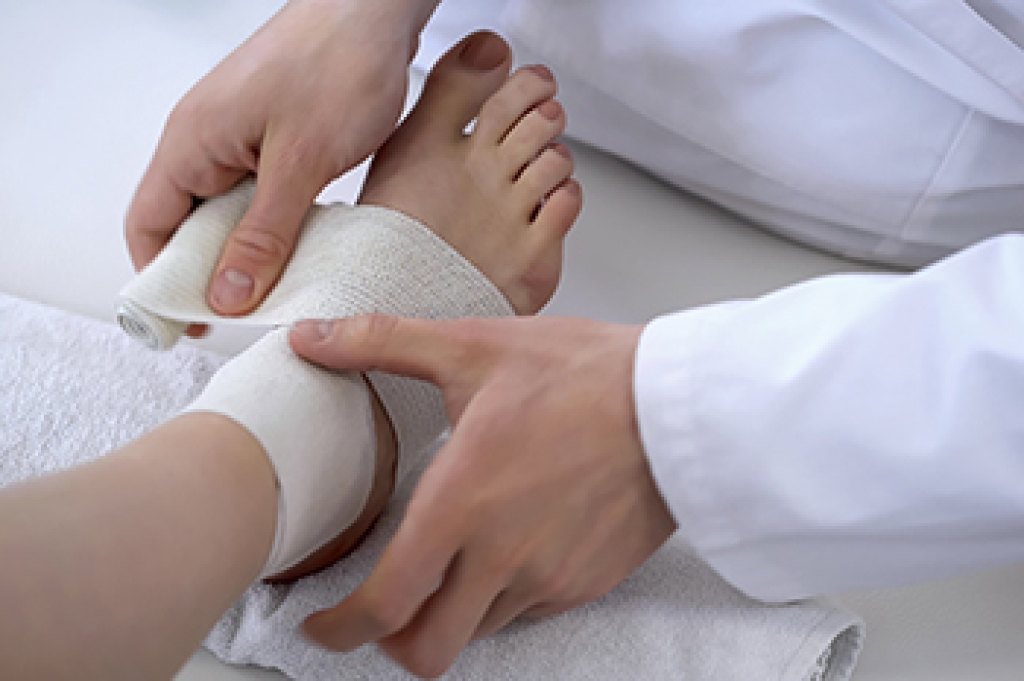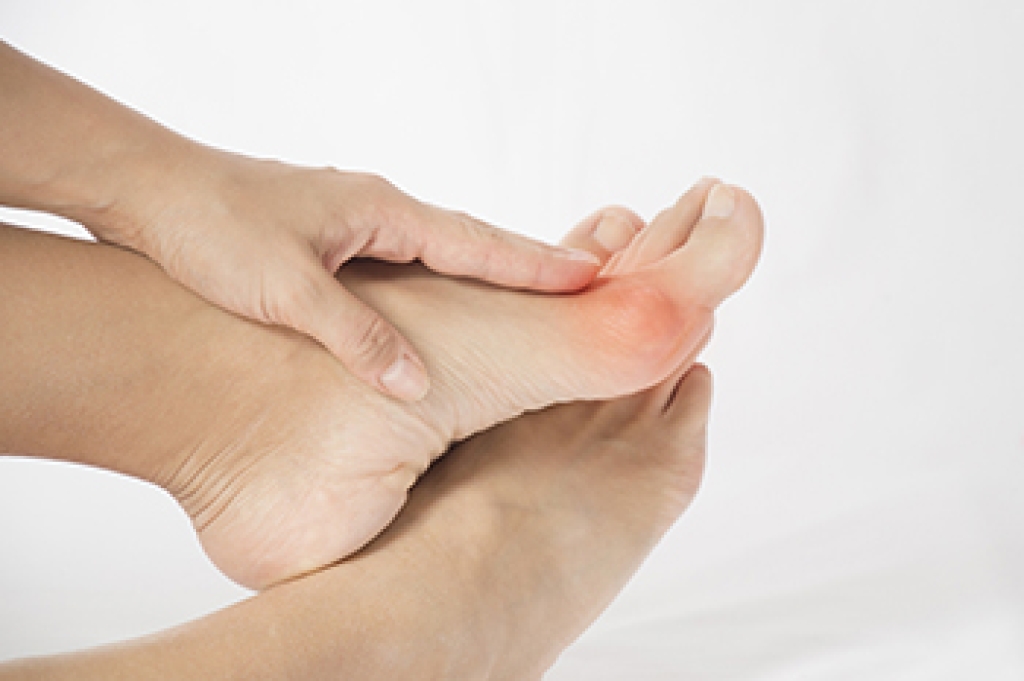Symptoms and Treatment for Ankle Sprains

Ankle sprains, a common injury, can occur when the ligaments connecting the bones in the ankle stretch or tear due to sudden twisting or rolling movements. Symptoms of an ankle sprain include pain, swelling, and tenderness around the affected area. Bruising may develop, and walking can be challenging, if not impossible. Prompt treatment is essential, and can begin with rest and wrapping the affected foot, and elevating it to reduce the swelling. Performing gentle exercises and stretches can help regain strength and flexibility. Depending on the severity, a medical professional might recommend braces, crutches, or physical therapy. Restoring full functionality involves diligent adherence to the prescribed rehabilitation plan. Understanding the symptoms and promptly seeking appropriate care can facilitate a smoother recovery from this discomforting setback. It is suggested that you see a chiropodist if you suffer from an ankle sprain.
When one or more ligaments in the ankle overstretch or tear due to injury, an ankle sprain occurs. If you would like to learn more about ankle sprains, please consult with one of the chiropodists from The Footcare Centre. Our chiropodists can help you maintain the health of your lower limbs and your mobility.
Symptoms of an ankle sprain vary depending on the severity of the injury, but may include:
- Pain
- Swelling
- Bruising
- Tenderness
- Difficulty walking
- Ankle instability
- A reduced range of motion in the ankle
Treatments for an ankle sprain may consist of:
- Resting the injured ankle
- Applying ice
- Elevating the ankle
- Compressing the ankle
- Over-the-counter pain medications
- Ankle braces or other devices to take weight off of the ankle
- Ankle exercises
- Surgery (in rare cases)
It’s important for the sprained ankle to heal correctly and fully in order to avoid repeated injury. If you have any questions, please feel free to contact our office located in . We offer the newest diagnostic and treatment technologies for all your foot care needs.
Tired, Achy Feet

Tired and achy feet, while not a medical condition in and of itself, often result from overworked foot muscles. Our feet endure substantial pressure and movement, causing fatigue. This sensation can affect daily activities and slow us down. Various factors contribute to tired and achy feet. Overuse, such as prolonged standing or walking, is a significant cause. Inadequate footwear, especially lacking arch support and cushioning, can lead to foot discomfort. Walking on hard surfaces, high or fallen arches, excess weight, and foot conditions like heel spurs or plantar fasciitis can intensify these feelings. Relief and prevention of tired and achy feet can include rest, foot soaks, massage, stretching and strengthening exercises, and wearing shoes with adequate arch support and shock absorption with insoles or orthotics. If you have tired, achy feet, it is suggested that you make an appointment with a chiropodist to see if the underlying cause can be identified and treated.
Foot pain is a common problem treated by chiropodists. If you have foot pain, please consult with one of the chiropodists from The Footcare Centre. Our chiropodists can help you maintain the health of your lower limbs and your mobility.
When you are experiencing foot pain, it’s important to note the type of pain and its location, as this can help determine a diagnosis.
Pain in the top of the foot may be caused by:
- Stress fractures
- Sinus tarsi syndrome
- Extensor tendonitis
- Tibialis anterior tendonitis
- Gout
- Athlete’s foot
- Ganglion cysts
Pain in the bottom of the foot may be caused by:
- Plantar fasciitis
- Foot cramps
- Tarsal tunnel syndrome
- Plantar fibromatosis
- Posterior tibial tendonitis
- Stress fractures
- Flat feet
Pain on the side of the foot may be caused by:
- Ankle sprain
- Cuboid syndrome
- Peroneal tendonitis
- Stress fractures
- Bunions
- Corns or calluses
- Posterior tibial tendonitis
Heel pain may be caused by:
- Plantar fasciitis
- Achilles tendonitis
- Bone spurs
- Heel fractures
- Retrocalcaneal bursitis
- Sever’s disease
Pain in the toes may be caused by:
- Gout
- Hammertoe
- Turf toe
- Bunions
- Ingrown toenails
- Blisters
- Arthritis
These and many more conditions can be treated by a chiropodist. If you have any questions, please feel free to contact our office located in . We offer the newest diagnostic and treatment technologies for all your foot care needs.
The Difference Between Bunions and Gout

Bunions and gout share similarities in their impact on the big toe. Both are characterized by pain, swelling, and redness, often leading to walking discomfort. However, they possess fundamental differences in origin and treatment. Bunions are localized foot deformities, while gout is a systemic issue resulting from excessive uric acid production. Bunions arise from genetic or structural foot anomalies and are impacted by footwear, while gout stems from hyperuricemia triggered by purine-rich foods. The location, sensation, and causes of each condition diverge. Bunions appear as bony protrusions at the big toe joint, while gout predominantly affects the big toe but also other joints. Gout attacks involve excruciating pain, heat, and tenderness, while bunions cause discomfort through structural changes. Diagnosing these conditions involves various tests, with gout requiring a more extensive evaluation to rule out similar conditions. Gout is confirmed through medical history, physical examination, uric acid blood tests, joint aspiration, and imaging. Bunion diagnosis involves physical assessment and X-rays. Gout management focuses on acute attack relief through lifestyle changes and medications to control uric acid levels. The initial treatment of bunions includes wearing proper footwear, taping, and arch supports. If you are having pain or discomfort in your big toe, it is suggested that you make an appointment with a chiropodist for a proper diagnosis and appropriate treatment.
Bunions progressively worsen over time and may cause walking in your shoes to become difficult. To learn more about bunions, please consult with one of the chiropodists from The Footcare Centre. Our chiropodists will assess your condition and provide you with quality foot and ankle treatment.
What Are Bunions?
A bunion is a bony bump that protrudes from the base of the big toe. Bunions are caused due to a misalignment of the first metatarsal. The characteristic bump of a bunion forms when the metatarsal shifts outwards from its proper position. Bunions develop slowly over time and progressively worsen without treatment. The skin over the bunion may develop calluses due to the friction from shoes. Eventually, a bunion can make walking uncomfortable or even painful. Bunions are one of the most common foot deformities and are especially common in women and older adults.
Symptoms
A bunion appears as a bulging bump on the outside of the base of the big toe.
The bunion may also:
- Be swollen, red, or sore
- Develop corns or calluses over it
- Cause pain
- Limit the big toe’s range of motion
Treatment
There are several different treatments available for bunions. Conservative treatment options include wearing shoes with a wider toe box, cushioning the bunion with a specialized pad, wearing shoe inserts, icing the bunion if it becomes inflamed, and taking medications to relieve pain. In more severe cases, more invasive procedures may be done. This may involve removing the swollen tissue around the bunion, straightening the big toe, realigning the bones at the front of the foot, or a combination of these procedures.
If you have any questions, please feel free to contact our office located in . We offer the newest diagnostic and treatment technologies for all your foot care needs


